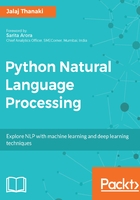
What this book covers
Chapter 1, Introduction, provides an introduction to NLP and the various branches involved in the NLP domain. We will see the various stages of building NLP applications and discuss NLTK installation.
Chapter 2, Practical Understanding of Corpus and Dataset, shows all the aspects of corpus analysis. We will see the different types of corpus and data attributes present in corpuses. We will touch upon different corpus formats such as CSV, JSON, XML, LibSVM, and so on. We will see a web scraping example.
Chapter 3, Understanding Structure of Sentences, helps you understand the most essential aspect of natural language, which is linguistics. We will see the concepts of lexical analysis, syntactic analysis, semantic analysis, handling ambiguities, and so on. We will use NLTK to understand all the concepts practically.
Chapter 4, Preprocessing, helps you get to know the various types of preprocessing techniques and how you can customize them. We will see the stages of preprocessing such as data preparation, data processing, and data transformation. Apart from this, you will understand the practical aspects of preprocessing.
Chapter 5, Feature Engineering and NLP Algorithms, is the core part of an NLP application. We will see how different algorithms and tools are used to generate input for machine learning algorithms, which we will be using to develop NLP applications. We will also understand the statistical concepts used in feature engineering, and we will get into the customization of tools and algorithms.
Chapter 6, Advance Feature Engineering and NLP Algorithms, gives you an understanding of the most recent concepts in NLP, which are used to deal with semantic issues. We will see word2vec, doc2vec, GloVe, and so on, as well as some practical implementations of word2vec by generating vectors from a Game of Thrones dataset.
Chapter 7, Rule-Based System for NLP, details how we can build a rule-based system and all the aspects you need to keep in mind while developing the same for NLP. We will see the rule-making process and code the rules too. We will also see how we can develop a template-based chatbot.
Chapter 8, Machine Learning for NLP Problems, provides you fresh aspects of machine learning techniques. We will see the various algorithms used to develop NLP applications. We will also implement some great NLP applications using machine learning.
Chapter 9, Deep Learning for NLU and NLG Problems, introduces you to various aspects of artificial intelligence. We will look at the basic concepts of artificial neural networks (ANNs) and how you can build your own ANN. We will understand hardcore deep learning, develop the mathematical aspect of deep learning, and see how deep learning is used for natural language understanding(NLU) and natural language generation (NLG). You can expect some cool practical examples here as well.
Appendix A, Advance Tools, gives you a brief introduction to various frameworks such as Apache Hadoop, Apache Spark, and Apache Flink.
Appendix B, How to Improve Your NLP Skills, is about suggestions from my end on how to keep your NLP skills up to date and how constant learning will help you acquire new NLP skills.
Appendix C, Installation Guide, has instructions for installations required.